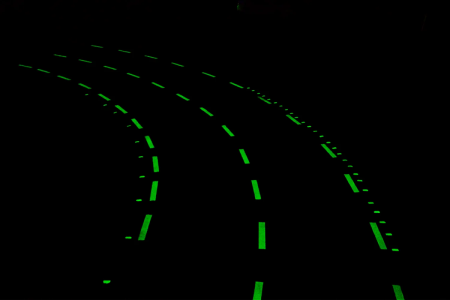‘It could save people’s lives’: The road idea lighting up Australia (and it’s just the beginning)
By
Maan
- Replies 0
More roads across Australia's most populated state could soon emit an eerie glow after dark.
An unusual safety trial tucked away on a notoriously steep pass quietly produced remarkable results.
Now, authorities are preparing to expand the experiment—but not everyone in the country has been convinced.
In December, a 200-metre stretch of Bulli Pass in New South Wales became the testbed for an innovative new type of road marking.
The steep descent—south of Sydney and frequently used by trucks and motorcycles—was known for its sharp bend and troubling safety record, with 125 near-accidents reported in just 12 months.
That danger zone is where Transport for NSW rolled out photoluminescent line markings designed to absorb sunlight by day and glow at night.
The goal was simple: help drivers ‘better see line markings’ at night or during bad weather, especially where street lighting wasn’t viable.
By June, authorities had noted a 67 per cent reduction in nighttime near misses at the site.
Community response was also strong, with 83 per cent of drivers surveyed reporting the glow gave them ‘increased peace of mind’ while navigating the bend.
‘The benefit of the glow was greatest in improving visibility beyond the range of vehicle headlights—increasing the visibility of the lines on the bend to just below daylight detectability when the glow was fully charged,’ a Transport for NSW spokesperson told Yahoo News.
They confirmed additional locations were now being reviewed for rollout due to the ‘early success’ of the Bulli Pass installation.
The technology has broader ambitions too, with advocates saying it could help Australia meet its zero deaths and serious injuries target by 2050.
Glow-in-the-dark line markings could eventually appear on footpaths, bike trails, helicopter landing pads and airport runways.
Clive Todd, founder of Lihten, previously shared his vision: ‘I want it to be in the key places which would help save lives… It’s environmentally friendly, it saves electricity and it could save people’s lives.’
But not every trial has shone so brightly.
In 2022, Victoria trialled the same concept over a 1-kilometre stretch of Metong Road in the state’s southeast.
However, a VicRoads spokesperson confirmed in July that the $4 million project had been scrapped.
An independent review found the safety benefits were not significant enough to justify further investment.
That outcome contrasted sharply with NSW’s glow road experiment, which appears poised to expand in the coming months.
If you found the idea of glow-in-the-dark road markings interesting, there’s more innovation on the horizon.
Another state is trialling a different kind of road technology—one that goes beyond paint and directly taps into real-time driver safety.
It’s a bold move that could completely change the way we experience the roads.
Read more: This Australian state is about to revolutionise road safety with groundbreaking technology—here’s how it’ll affect you

Would you feel safer driving if the roads lit up after dark?
An unusual safety trial tucked away on a notoriously steep pass quietly produced remarkable results.
Now, authorities are preparing to expand the experiment—but not everyone in the country has been convinced.
In December, a 200-metre stretch of Bulli Pass in New South Wales became the testbed for an innovative new type of road marking.
The steep descent—south of Sydney and frequently used by trucks and motorcycles—was known for its sharp bend and troubling safety record, with 125 near-accidents reported in just 12 months.
That danger zone is where Transport for NSW rolled out photoluminescent line markings designed to absorb sunlight by day and glow at night.
The goal was simple: help drivers ‘better see line markings’ at night or during bad weather, especially where street lighting wasn’t viable.
By June, authorities had noted a 67 per cent reduction in nighttime near misses at the site.
Community response was also strong, with 83 per cent of drivers surveyed reporting the glow gave them ‘increased peace of mind’ while navigating the bend.
‘The benefit of the glow was greatest in improving visibility beyond the range of vehicle headlights—increasing the visibility of the lines on the bend to just below daylight detectability when the glow was fully charged,’ a Transport for NSW spokesperson told Yahoo News.
They confirmed additional locations were now being reviewed for rollout due to the ‘early success’ of the Bulli Pass installation.
The technology has broader ambitions too, with advocates saying it could help Australia meet its zero deaths and serious injuries target by 2050.
Glow-in-the-dark line markings could eventually appear on footpaths, bike trails, helicopter landing pads and airport runways.
Clive Todd, founder of Lihten, previously shared his vision: ‘I want it to be in the key places which would help save lives… It’s environmentally friendly, it saves electricity and it could save people’s lives.’
But not every trial has shone so brightly.
In 2022, Victoria trialled the same concept over a 1-kilometre stretch of Metong Road in the state’s southeast.
However, a VicRoads spokesperson confirmed in July that the $4 million project had been scrapped.
An independent review found the safety benefits were not significant enough to justify further investment.
That outcome contrasted sharply with NSW’s glow road experiment, which appears poised to expand in the coming months.
If you found the idea of glow-in-the-dark road markings interesting, there’s more innovation on the horizon.
Another state is trialling a different kind of road technology—one that goes beyond paint and directly taps into real-time driver safety.
It’s a bold move that could completely change the way we experience the roads.
Read more: This Australian state is about to revolutionise road safety with groundbreaking technology—here’s how it’ll affect you
Key Takeaways
- Photoluminescent markings absorb sunlight and glow at night to improve visibility.
- NSW trialled the feature at Bulli Pass and saw a 67 per cent drop in nighttime near misses.
- Community feedback revealed increased driver confidence and peace of mind.
- Victoria trialled a similar system but discontinued it due to insufficient safety benefits.
Would you feel safer driving if the roads lit up after dark?








